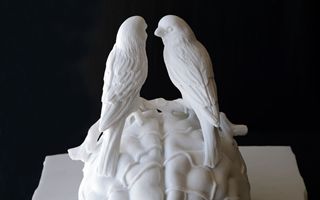(Finance) – It was held on January 30th, at the Mucciaccia Gallery of Rome a stone’s throw from Piazza di Spagna, the inauguration of the exhibition dedicated to Jan FabreBelgian artist of internationally renowned, with his most recent works for the first time in Italy, exhibited to the public until 1 March 2025: “Songs of the Canaries (A Tribute to Emel Fabre and Robert Stroud)” And “Songs of the Gypsies (a tribute to Django Reinhardt and Django Gennaro Fabre)”composed in total by 11 carrara marble sculptures and 40 drawings.
Born in Antwerp in 1958, Jan Fabre is recognized as one of the most innovative and versatile figures in the contemporary artistic panorama, and is particularly fond of Italy and its major artists. His career, which began in the 80s, embraces different disciplines, including visual arts, theater, choreography and writing, all linked by a Fil Rouge: the provocative and visionary approach, curiosity towards themes connected to corporeality, metamorphosis and the relationship between art and science, the ability to welcome fears and fragility, the weight of reflection.
“Songs of the Canaries”: a tribute to fragility and freedom between physical and mental prisons
The first section of the exhibition, “Songs of the Canaries”he is a tribute to EMIEL Fabre, brother of the artist, and Robert Stroud, an American criminal and ornithologist known as the “Birdman of Alcatraz” for his in -depth studies on the canaries while he was in prison. The works in this series combine Carrara marble sculptures and designs made with colored pencils on Vantablackthe most black material existing in the world, creating a clear and intense visual contrast that emphasizes the delicacy of the subjects represented. The sculptures depict canaries laid on human brains, and symbolize the invisible yet powerful interconnection between thought and freedom: works like “Thinking Outside The Cage” (2024) e “Sharing Secrets About the Neurons” (2024) For example, invite the viewer to reflect on the complexity of the human mind and on the innate desire that man has to transcend his limits. Central protagonist of this section is “The Man Who Measures His Own Planet” (2024), a monumental sculpture that represents a figure intent on measuring the immensity of the sky, with the skull open to reveal the brain, symbol of the exploration of the unknown and the search for knowledge.
“Songs of the Gypsies”: a dialogue between music and sculpture under the sign of resilience
The second part of the exhibition, “Songs of the Gypsies”pays homage to the legendary jazz guitarist Django Reinhardtwhich despite an important impairment to the left hand became an icon of world music for the innovative scope of his technique, and to the artist’s son, Django Gennaro Fabre. The works in this series include Carrara marble sculptures that depict a newborn, inspired by the son of Fabre, in poses that evoke the energy and creativity of jazz. Here the sculptures are accompanied by engravings of musical scores, with the ultimate goal of creating an interaction between visual form and sound by combining two expressive languages
apparently distant.
The vision of Jan Fabre’s art and life
Jan Fabre’s work has always been characterized by a profound exploration of the human condition, often through the lens of fragility and change. The use of materials such as the white carrara marble and the very black Vantablack, then, is not at all random: marble represents tradition and permanencewhile the Vantablack, with its ability to absorb almost all the light, symbolizes the unknown and the infinite. Black and white together, forced to reflect each other and live together to redesign the physical space of the Capitoline preparation, as well as the intangible space that each of us leaves internally for the compromise, the challenge, the beauty, the truth, the knowledge.
The artist frequently integrates references to science and nature in his works (the representation of human brains and canaries in “Songs of the Canaries”; for example, he underlines Fabre’s interest in neurology and psychology), creating a dialogue constant, and in some ways also controversial, between art and knowledge (the tribute to Django Reinhardt in “Songs of the Gypsies” places the accent on the importance of resilience and creativity in facing the challenges of life).
For Fabre, therefore, art is a means for explore the depths of human experience but also to challenge the social and cultural conventionsand its artistic practice represents an incessant search for truth and beauty, often through the exploration of taboo topics.
The artist, in his vision, is a “Warrior of beauty” (So writes the Belgian visionary in from action to acting. The guidelines of Jan Fabre for the twenty -century performer), who, convinced of the art ability to raise human experience, continuously struggling to bring to light – and make acceptable, sustainable, scalable – the numerous and unfathomable contradictions of life itself.
(Photo: Photo Pierluigi Di Pietro)
